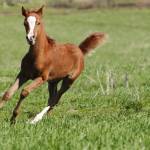Dietary Factors in Equine Developmental Orthopedic Disease

Developmental orthopedic disease (DOD) is a significant economic problem for modern horse breeders because the crippling lameness can make affected foals or yearlings essentially worthless. A single factor that can prevent DOD has not been identified, but several are known to be important. Nutrition is an important factor, and awareness of the problem has led to the design of feeding and management programs to decrease the incidence and severity of the disease.
Mineral Deficiencies
Amounts and ratios between copper and zinc are related to some cases of DOD. Proper feed formulation can help to prevent DOD in foals. Most natural feeds do not contain sufficient copper and zinc, which are inexpensive and nontoxic, so high levels of supplementation are suggested; however, excessively high levels will also predispose to DOD. Rations for late-pregnant mares and young horses should provide adequate copper and zinc intakes.
Copper supplementation, together with zinc and selenium, of pasture-fed pregnant mares can lead to a significant reduction in the incidence and severity of physitis and articular cartilage lesions in their weanlings. Interestingly, supplementation of the mares and foals after birth does not reduce the incidence of DOD. If the mare has been supplemented in late pregnancy, the foal will have built up adequate stores of trace minerals in the liver prior to birth. Milk is a relatively poor source of these minerals. Other minerals such as manganese, sulphur, and magnesium are involved in the formation of bone and maturation of cartilage, and deficiencies of calcium and phosphorus will drastically affect skeletal development.
Be aware of the need for calcium, particularly when high-grain diets are fed. The phosphorus content of grains and hay is not readily available, but the addition of live yeast culture to the diet of growing horses and late-pregnant mares can improve both the availability of phosphorus and other minerals for rapid growth and overall feed digestibility. Chromium can enhance glucose metabolism in young horses, which reduces the insulin and cortisol levels after feeding grain and may be useful in reducing the risk of osteochondrosis in young horses.
Mineral Excess
Foals consuming high levels of zinc in conjunction with marginally deficient levels of copper have a severe risk of DOD because zinc interferes with the absorption and utilization of copper, thus creating a deficiency. Excess phosphorus increases the risk of DOD, such as when foals are fed very large amounts of grain or bran. High-calcium diets have also been implicated in the development of DOD, perhaps by reducing the availability of other minerals and thus creating deficiencies. Excessive calcium supplementation can occur in young horses eating large amounts of lucerne (alfalfa) and a calcium-only supplement such as ground limestone. The diet for the growing horse should have a calcium to phosphorus ratio of 1.1:1–2:1. Have your horse’s diet analyzed by a veterinarian or nutritionist to check that these minerals are being supplied in the correct amounts and proportions. Excessive manganese may lead to problems if the diet is marginal for copper. The copper to manganese ratio also needs to be considered if there is a higher than normal incidence of DOD. Some pastures accumulate manganese and will need to be tested.
Overfeeding
Horses that are forced to grow at a rapid rate are more prone to DOD. Overly fat young horses will not become good athletes; a study of 10,000 Thoroughbred yearlings in the United States and England showed that overweight and obese yearlings performed substantially less well on the racetrack. Breeders can monitor the body condition of growing horses and should not let them get too fat. Remember that exercise is important for young horses and can limit the side effects of a high-energy diet. When weanlings and yearlings are confined or cannot exercise because of lameness, reduce the amount of grain and slowly reintroduce them to exercise. One of the new theories for the development of DOD is sensitivity of cartilage to insulin, so management procedures that reduce the post-feeding levels of insulin are recommended, such as small amounts of grain in each meal, dilution of the grain with chaff, added fat for energy, and added chromium.
Owners of young horses can reduce the risk of DOD in their equines by using a high-grade commercial feed designed to meet the nutritional needs at this stage of growth. Feeding directions on the bag should be followed to ensure horses are getting the right amounts and ratios of important nutrients.








